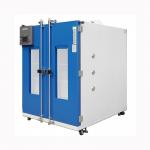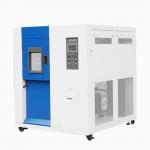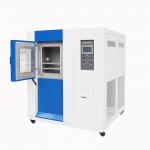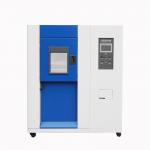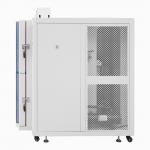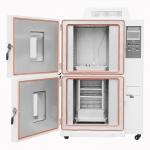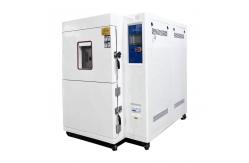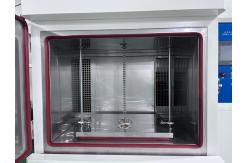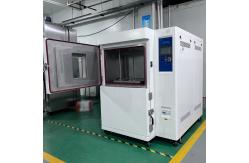In the highly demanding and mission-critical field of military
applications, the performance and durability of equipment and
components are non-negotiable. The Customization Thermal Shock Test
Chamber, which adheres to MIL STD (Military Standard) standards, is
a vital tool for evaluating the resilience of various products
against rapid and extreme temperature changes. This specialized test chamber is designed to subject military
hardware, electronics, and materials to severe thermal shock
conditions. It serves military contractors, defense research
institutions, and quality control departments. The core purpose is
to simulate the rapid temperature transitions that military
equipment may encounter during deployment, such as from the extreme
cold of high-altitude flights to the intense heat of desert
operations or the rapid heating and cooling associated with weapon
firing. By conducting these tests, potential weaknesses and
failures in products can be identified and addressed, ensuring that
only the most reliable and robust items reach the field. - Robust and Rugged Construction
- The test chamber is built with a heavy-duty framework, typically
fabricated from high-strength alloy steel, to withstand the rigors
of military testing. The exterior is designed to be highly durable
and resistant to corrosion, abrasion, and other environmental
stresses. The interior is lined with a refractory material that can
endure the rapid temperature fluctuations without degrading or
contaminating the test samples. The door of the chamber is
engineered with a reliable sealing mechanism and a heavy-duty
latch, ensuring an airtight and secure enclosure. It also features
a viewing window made of toughened, heat-resistant glass, allowing
for visual inspection of the testing process.
- Precision Temperature Control Systems
- Temperature Range: Capable of achieving a wide temperature range,
typically from -70°C to +150°C or even more extreme temperatures
depending on customization. This broad spectrum allows for the
simulation of the most inhospitable environments that military
equipment might face. The temperature control is highly accurate,
with an error margin of ±1°C, ensuring reliable and repeatable test
results.
- Rapid Temperature Transition: The chamber can execute extremely
rapid temperature changes. It can shift from one extreme
temperature to another in a matter of minutes, replicating the
sudden thermal shocks that occur in real-world military scenarios.
For example, it can transition from a frigid -60°C to a blistering
+120°C in less than 10 minutes, depending on the specific
requirements and chamber configuration.
- Temperature Uniformity: Maintains excellent temperature uniformity
within the chamber, with a variation of no more than ±2°C across
the testing volume. This ensures that all parts of the test sample
are subjected to the same thermal stress, providing accurate and
consistent test data.
- Advanced Instrumentation and Data Acquisition
- The chamber is equipped with a comprehensive suite of sensors.
Temperature sensors are strategically placed both inside and
outside the chamber to monitor the temperature gradients and ensure
proper operation. Pressure sensors are installed to detect any
abnormal pressure changes that could affect the test or indicate a
potential failure of the sample. Additionally, vibration sensors
can be incorporated to assess the impact of thermal shock on the
mechanical integrity of the sample. These sensors are connected to
a state-of-the-art data acquisition system that records and stores
all the relevant data. The data can be accessed and analyzed in
real-time or retrieved later for in-depth studies. The system can
generate detailed reports and graphs, facilitating the
interpretation and communication of test results. It also has the
ability to set alarm thresholds, alerting operators if any
parameter exceeds the specified limits.
- Compliance with MIL STD Standards and Safety Features
- The Customization Thermal Shock Test Chamber is designed and
manufactured to meet specific MIL STD standards, such as
MIL-STD-810 for environmental testing. It incorporates multiple
safety features to protect both the operators and the testing
facility. It has an automatic emergency shutdown system that
activates in case of any critical malfunction or if the temperature
exceeds the safe operating limits. The chamber is also equipped
with a fire suppression system, which can quickly extinguish any
flames that may occur due to a sample failure or electrical issue.
Ventilation systems are in place to remove any potentially harmful
gases or fumes that could be generated during the testing process.
The control panel is designed with safety interlocks and clear
warning indicators to prevent accidental operation and ensure the
well-being of the personnel.
- Chamber Size and Capacity: Available in various sizes to accommodate different military
equipment and components. The volume can range from a few cubic
feet for testing small electronic modules to several hundred cubic
feet for larger assemblies like missile guidance systems or vehicle
components. The interior dimensions are optimized for proper air
circulation and uniform temperature distribution, ensuring that all
parts of the sample are effectively tested.
- Temperature Cycling Rate: Can perform temperature cycles at a rate of several cycles per
hour, depending on the temperature range and the specific MIL STD
requirements. For example, it can conduct 3 to 5 cycles per hour
between -50°C and +100°C, subjecting the sample to repeated and
rapid thermal stress.
- Data Acquisition Rate: The data acquisition system can sample sensor data at a frequency
of 50 to 200 samples per second. This high sampling rate ensures
that even the most rapid changes in temperature, pressure, or other
parameters during the thermal shock are accurately recorded and can
be analyzed in detail.
- MIL STD Standard Compliance: Complies with a range of MIL STD standards related to thermal
shock testing, ensuring that the testing procedures are in line
with military requirements and that the results are recognized and
accepted by the defense industry.
- Accurate Simulation of Military Environmental Stress
- The primary function of this test chamber is to provide a highly
accurate and realistic simulation of the thermal shock conditions
that military equipment will face. By precisely controlling the
temperature transitions and maintaining uniformity, it allows for
the evaluation of how products will perform and degrade over time.
For example, it can determine if a military-grade electronic
circuit board will experience solder joint failures or component
damage due to the rapid expansion and contraction caused by thermal
shock. It can also assess the integrity of mechanical components,
such as the seals and housings of military weapons or the
structural integrity of aircraft parts. This information is crucial
for military contractors to optimize their product designs, select
appropriate materials, and improve the overall reliability and
durability of their equipment.
- The ability to conduct repeatable tests in accordance with MIL STD
standards is also a valuable function. This helps in comparing the
performance of different product versions or batches and
identifying the most suitable design or manufacturing process. For
instance, a manufacturer can test multiple prototypes of a new
military communication device under the same thermal shock
conditions and analyze the results to determine which design offers
the best resistance to thermal stress.
- Enhanced Military Product Quality and Safety Assurance
- Through comprehensive testing in the Customization Thermal Shock
Test Chamber, military product manufacturers can identify and
address potential issues in their designs. If a product shows signs
of failure or degradation during the test, appropriate measures can
be taken, such as modifying the material composition, improving the
manufacturing process, or adding additional thermal protection
features. This leads to the development of more reliable and
durable military equipment, reducing the risk of failures in the
field and enhancing the safety of military personnel. In the
research and development field, it allows for the exploration of
new materials and technologies, providing valuable data on their
behavior under extreme thermal shock conditions. For example,
researchers can study the performance of new composite materials
for military vehicle armor or advanced ceramics for missile
components.
- The test chamber also serves as a valuable tool for quality
control. By subjecting military products to standardized thermal
shock tests, manufacturers can ensure that their products meet the
required quality and performance standards. This helps in building
a reputation for quality and reliability in the highly competitive
military market, which is essential for winning contracts and
maintaining the trust of the military establishment.
|
